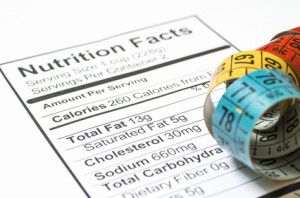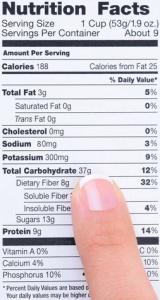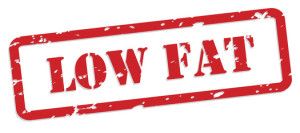
While we might strive to eat as healthy a diet as possible based in whole foods like lean meats, dairy, veggies, fruits and whole grains, the majority of us do eat processed foods regularly. We turn to these convenience foods to help us with time constraints in our busy lives and they are sometimes all we have at our disposal when we’re at work or on the road.
As you’re looking at aisles and aisles of boxed and canned products in the grocery store, do you ever feel confused as to what are the healthiest options? Each product seems to have a version that’s low-fat or fat-free, whole grain or multigrain, low carb or sugar free. How can you really know which option is best when healthy food trends seem to change year by year?
To make the grocery aisles less confusing, I’ll be writing a series of blog articles, one each week, to help us understand what the various processed food health claims actually mean. We’ll tackle FDA definitions, USDA recommendations and food industry standards to figure out what are the best options for our health, and where sometimes food labeling might lead us astray.
This second article in our series about processed food labels will help us figure out what “low fat” and “fat free” really mean.
A couple of decades ago, as the obesity epidemic began in America, dietary fats were being increasingly blamed as being the cause of the fat in our midsections. Fat was totally demonized by medical providers, and the food industry began to follow suit, producing low-fat and fat free versions of everything from dairy products to cookies and crackers.
The medical establishment now acknowledges that some dietary fats are necessary for health, so called ‘healthy fats’ like those found in nuts, avocados and fish. In fact, fats are actually necessary for both health and weight loss. However, many of us still tend to seek out low-fat or fat free foods in lieu of their full-fat cousins, like milk, cheeses and Starbucks pastries. It’s still easy to find low-fat and fat free versions of crackers, cookies, dairy products, microwave popcorn and other snacks at the grocery store.
Here are the important questions we must ask. Are low-fat and fat free versions of processed foods really healthier than their full fat counterparts? When fat is removed, what is added in to replace it?
WHAT DO LOW-FAT AND FAT FREE MEAN ON FOOD LABELS?
The FDA does regulate what can be labeled as low-fat and fat free. In order to meet the ‘low-fat’ definition, a product must contain 3 grams of fat or less per serving. Foods labeled ‘fat free’ must contain less than .5 grams of fat by law. It sounds pretty straightforward, but food processing tricks and labeling tweaks can complicate things.
Food manufacturers have a ton of leeway to mess with serving sizes on their labels. For example, let’s say a serving size for a given product is just one cookie (or even half a cookie), and that serving size contains 2 grams of fat. How often do you eat just one little cookie out of the box? That’s the problem. By the time you’ve eaten 3, 5 or 10 cookies, your treat is no longer ‘low-fat.’
ADDED SUGAR IN LOW-FAT AND FAT FREE FOODS
As the medical community has now begun to discover, low-fat and fat free processed foods have actually contributed greatly to the obesity epidemic. That’s because of all the sugar that has to be added to make up for the missing fat. Fat contributes greatly to flavor in foods. Once it’s removed, food manufacturers add lots of additional sugar to improve the flavor. The result is a low-fat or fat free food that has more calories and a worse effect on your insulin levels and metabolism than the original ‘full-fat’ version.

Let’s face it, although it may not be what we want to hear, we know that there is no such thing as a healthy cookie or healthy candy. Some cookies and candy are worse than others, and the low-fat and fat free versions just aren’t any healthier than the regular brand. And they’re as bad or worse for weight loss.
Your best bet is to base your diet in healthy whole foods as much as possible. If you do choose to eat processed foods, read the labels to determine serving size, amount of calories and amount of sugar in the box. When you need an occasional sweet treat, consider making them at home instead of purchasing the processed variety. Check out these posts about Healthy Chocolate Desserts, Clean Eating Cookies and even Clean Eating Candy.
Are you looking for a nutrition plan that removes the confusion of making healthy food choices? Our Athlean-XX for Women nutrition plan recommends combining lean proteins, fruits and vegetables, and slow-burning carbohydrates at every meal and snack to help keep you feeling full. In fact, the Athlean-XX for Women nutrition plan is anything but a diet – we actually recommend you eat MORE – 5 – 6 times per day! This type of diet will help turn your metabolism into a fat burning machine – when combined with our killer 30 minute workouts. Yes, with Athlean-XX for Women, eat more, exercise shorter but harder and weigh less! Join us on Team Athlean to start your lifestyle makeover now!
And finally, if you’d like to stay up to date with the AthleanXXforWomen.com blog, then please like us on Facebook, follow us on Twitter and follow us on Pinterest.
P.S. We are a growing community dedicated to and passionate about realistic fitness and nutrition for REAL women. If you enjoyed this post please feel free to share on Facebook, Twitter and Pinterest. It would be incredibly appreciated.





